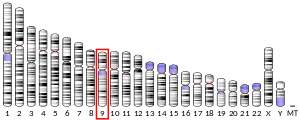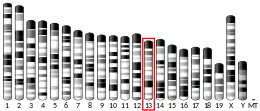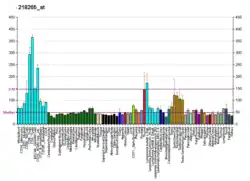SECISBP2
SECIS-binding protein 2 (commonly referred to as SBP2) is a protein that in humans is encoded by the SECISBP2 gene.[5][6]
Function
The incorporation of selenocysteine into a protein requires the concerted action of an mRNA element called a sec insertion sequence (SECIS), a selenocysteine-specific translation elongation factor and a SECIS binding protein. With these elements in place, a UGA codon can be decoded as selenocysteine. SBP2 is a nuclear protein that functions as a SECIS binding protein, but experimental evidence indicates that SBP2 is cytoplasmic.[6]
Clinical significance
Mutations in this gene have been associated with a reduction in activity of a specific thyroxine deiodinase, a selenocysteine-containing enzyme, and abnormal thyroid hormone metabolism.[6]
See also
References
- GRCh38: Ensembl release 89: ENSG00000187742 - Ensembl, May 2017
- GRCm38: Ensembl release 89: ENSMUSG00000035139 - Ensembl, May 2017
- "Human PubMed Reference:". National Center for Biotechnology Information, U.S. National Library of Medicine.
- "Mouse PubMed Reference:". National Center for Biotechnology Information, U.S. National Library of Medicine.
- Wiemann S, Weil B, Wellenreuther R, Gassenhuber J, Glassl S, Ansorge W, Böcher M, Blöcker H, Bauersachs S, Blum H, Lauber J, Düsterhöft A, Beyer A, Köhrer K, Strack N, Mewes HW, Ottenwälder B, Obermaier B, Tampe J, Heubner D, Wambutt R, Korn B, Klein M, Poustka A (March 2001). "Toward a catalog of human genes and proteins: sequencing and analysis of 500 novel complete protein coding human cDNAs". Genome Research. 11 (3): 422–35. doi:10.1101/gr.GR1547R. PMC 311072. PMID 11230166.
- "Entrez Gene: SECISBP2 SECIS binding protein 2".
Further reading
- Bonaldo MF, Lennon G, Soares MB (September 1996). "Normalization and subtraction: two approaches to facilitate gene discovery". Genome Research. 6 (9): 791–806. doi:10.1101/gr.6.9.791. PMID 8889548.
- Copeland PR, Fletcher JE, Carlson BA, Hatfield DL, Driscoll DM (January 2000). "A novel RNA binding protein, SBP2, is required for the translation of mammalian selenoprotein mRNAs". The EMBO Journal. 19 (2): 306–14. doi:10.1093/emboj/19.2.306. PMC 305564. PMID 10637234.
- Hartley JL, Temple GF, Brasch MA (November 2000). "DNA cloning using in vitro site-specific recombination". Genome Research. 10 (11): 1788–95. doi:10.1101/gr.143000. PMC 310948. PMID 11076863.
- Low SC, Grundner-Culemann E, Harney JW, Berry MJ (December 2000). "SECIS-SBP2 interactions dictate selenocysteine incorporation efficiency and selenoprotein hierarchy". The EMBO Journal. 19 (24): 6882–90. doi:10.1093/emboj/19.24.6882. PMC 305907. PMID 11118223.
- Lescure A, Allmang C, Yamada K, Carbon P, Krol A (May 2002). "cDNA cloning, expression pattern and RNA binding analysis of human selenocysteine insertion sequence (SECIS) binding protein 2". Gene. 291 (1–2): 279–85. doi:10.1016/S0378-1119(02)00629-7. PMID 12095701.
- Allmang C, Carbon P, Krol A (October 2002). "The SBP2 and 15.5 kD/Snu13p proteins share the same RNA binding domain: identification of SBP2 amino acids important to SECIS RNA binding". RNA. 8 (10): 1308–18. doi:10.1017/S1355838202020034. PMC 1370339. PMID 12403468.
- Wiemann S, Arlt D, Huber W, Wellenreuther R, Schleeger S, Mehrle A, Bechtel S, Sauermann M, Korf U, Pepperkok R, Sültmann H, Poustka A (October 2004). "From ORFeome to biology: a functional genomics pipeline". Genome Research. 14 (10B): 2136–44. doi:10.1101/gr.2576704. PMC 528930. PMID 15489336.
- Rual JF, Venkatesan K, Hao T, Hirozane-Kishikawa T, Dricot A, Li N, Berriz GF, Gibbons FD, Dreze M, Ayivi-Guedehoussou N, Klitgord N, Simon C, Boxem M, Milstein S, Rosenberg J, Goldberg DS, Zhang LV, Wong SL, Franklin G, Li S, Albala JS, Lim J, Fraughton C, Llamosas E, Cevik S, Bex C, Lamesch P, Sikorski RS, Vandenhaute J, Zoghbi HY, Smolyar A, Bosak S, Sequerra R, Doucette-Stamm L, Cusick ME, Hill DE, Roth FP, Vidal M (October 2005). "Towards a proteome-scale map of the human protein-protein interaction network". Nature. 437 (7062): 1173–8. doi:10.1038/nature04209. PMID 16189514. S2CID 4427026.
- Dumitrescu AM, Liao XH, Abdullah MS, Lado-Abeal J, Majed FA, Moeller LC, Boran G, Schomburg L, Weiss RE, Refetoff S (November 2005). "Mutations in SECISBP2 result in abnormal thyroid hormone metabolism". Nature Genetics. 37 (11): 1247–52. doi:10.1038/ng1654. PMID 16228000. S2CID 35631638.
- Mehrle A, Rosenfelder H, Schupp I, del Val C, Arlt D, Hahne F, Bechtel S, Simpson J, Hofmann O, Hide W, Glatting KH, Huber W, Pepperkok R, Poustka A, Wiemann S (January 2006). "The LIFEdb database in 2006". Nucleic Acids Research. 34 (Database issue): D415-8. doi:10.1093/nar/gkj139. PMC 1347501. PMID 16381901.
- Papp LV, Lu J, Striebel F, Kennedy D, Holmgren A, Khanna KK (July 2006). "The redox state of SECIS binding protein 2 controls its localization and selenocysteine incorporation function". Molecular and Cellular Biology. 26 (13): 4895–910. doi:10.1128/MCB.02284-05. PMC 1489162. PMID 16782878.
This article is issued from Wikipedia. The text is licensed under Creative Commons - Attribution - Sharealike. Additional terms may apply for the media files.




